The Modelling of the Evapotranspiration Portion of the Water Footprint: A Global Sensitivity Analysis in the Brazilian Serra Gaúcha
Abstract
:1. Introduction
1.1. Previous Studies
1.2. Proposed Current Study
2. Materials and Methods
2.1. Modelling
2.1.1. The Reference Evapotranspiration Model
2.1.2. Crop Evapotranspiration Model
2.1.3. Water Footprint Model
2.2. Brazilian Serra Gaúcha
2.3. Global Sensitivity Analysis Techniques
2.3.1. Sampling Strategy
2.3.2. Analysis of Elementary Effects (EEs)
2.3.3. Fourier Amplitude Sensitivity Testing—FAST
2.4. Assumptions of This Study
- The analysis considers only latitude, altitude, the fraction of mulch covering the soil, and the temperatures during three months (October, November, and December) in the water footprint for the wine production;
- The water footprint only considers the evapotranspiration portion of the viticulture of wine production;
- Temperatures, relative humidities, and wind speeds are considered to be the same for the different latitudes and altitudes (this assumption may be reasonable considering the small size of the region under consideration; on the other hand, new studies can be conducted considering the uncertainties in temperatures and wind speeds, for instance). Additionally, as already evidenced, the range of variation in the maximum temperatures is higher than the real differences in the regions under study.
3. Results
4. Discussion
5. Conclusions
Author Contributions
Funding
Data Availability Statement
Conflicts of Interest
Abbreviations
| EE | elementary effects. |
| FAO | Food and Agriculture Organization. |
| FAST | Fourier Amplitude Sensitivity Test. |
| LHS | Latin Hypercube Sampling. |
| VBSA | Variance-Based Sensitivity Analysis. |
| WF | water footprint. |
Appendix A. Evapotranspiration Model
References
- Finco, A.; Bentivoglio, D.; Chiaraluce, G.; Alberi, M.; Chiarelli, E.; Maino, A.; Mantovani, F.; Montuschi, M.; Raptis, K.G.C.; Semenza, F.; et al. Combining Precision Viticulture Technologies and Economic Indices to Sustainable Water Use Management. Water 2022, 14, 1493. [Google Scholar] [CrossRef]
- Saraiva, A.; Presumido, P.; Silvestre, J.; Feliciano, M.; Rodrigues, G.; Silva, P.O.e.; Damásio, M.; Ribeiro, A.; Ramôa, S.; Ferreira, L.; et al. Water Footprint Sustainability as a Tool to Address Climate Change in the Wine Sector: A Methodological Approach Applied to a Portuguese Case Study. Atmosphere 2020, 11, 934. [Google Scholar] [CrossRef]
- Wurz, D.A.; Brighenti, A.F. Analysis of Brazilian wine competitiveness. BIO Web Conf. 2019, 12, 03015. [Google Scholar] [CrossRef]
- Alderete, M.V. The Wine Clusters of Mendoza and Serra Gaúcha: A Local Development Perspective. Front. Norte 2014, 26, 179–204. (In Spanish) [Google Scholar]
- Zen, A.C.; Fensterseifer, J.E.; Prévot, F. The influence of resources on the internationalisation process of clustered wine companies. Int. J. Bus. Glob. 2012, 8, 30–48. [Google Scholar] [CrossRef]
- Fensterseifer, J.E. The emerging Brazilian wine industry: Challenges and prospects for the Serra Gaúcha wine cluster. Int. J. Wine Bus. Res. 2007, 19, 187–206. [Google Scholar] [CrossRef]
- Hoekstra, A.; Hung, P. Virtual Water Trade: A Quantification of Virtual Water Flows between Nations in Relation to International Crop Trade; Value of Water. Research Report Series No. 11; IHL Delft: Delft, The Netherlands, 2002. [Google Scholar]
- Herath, I.; Green, S.; Singh, R.; Horne, D.; van der Zijpp, S.; Clothier, B. Water footprinting of agricultural products: A hydrological assessment for the water footprint of New Zealand’s wines. J. Clean. Prod. 2013, 41, 232–243. [Google Scholar] [CrossRef]
- Bonamente, E.; Scrucca, F.; Asdrubali, F.; Cotana, F.; Presciute, A. The Water Footprint of the Wine Industry: Implementation of an Assessment Methodology and Application to a Case Study. Sustentability 2015, 7, 12190–12208. [Google Scholar] [CrossRef]
- Jairman, C. Water Footprint as an Indicator of Sustainable Table and Wine Grape Production; Technical Report; Water Research Comission: Gezina, South Africa, 2020. [Google Scholar]
- Saraiva, A.; Rodrigues, G.; Silvestre, J.; Feliciano, M.; Silva, P.; Oliveira, M. A pegada hídrica na fileira vitivinícola portuguesa. Agrotec 2019, 35, 68–70. (In Portuguese) [Google Scholar]
- Allen, R.; Walter, I.; Elliot, R.; Howell, T.; Itenfisu, D.; Jensen, M. The ASCE Standardized Reference Evapotranspiration Equation; ASCE: Reston, VA, USA, 2005. [Google Scholar]
- Adib, A.; Kalantarzadeh, S.S.O.; Shoushtari, M.M.; Lotfirad, M.; Liaghat, A.; Oulapour, M. Sensitive analysis of meteorological data and selecting appropriate machine learning model for estimation of reference evapotranspiration. Appl. Water Sci. 2023, 13, 83. [Google Scholar] [CrossRef]
- Ndiaye, P.; Bodian, A.; Diop, L.; Djaman, K. Sensitivity Analysis of the Penman-Monteith Reference Evapotranspiration to Climatic Variables: Case of Burkina Faso. J. Water Resour. Prot. 2017, 9, 1364–1376. [Google Scholar] [CrossRef]
- Ndiaye, P.M.; Bodian, A.; Diop, L.; Dezetter, A.; Guilpart, E.; Deme, A.; Ogilvie, A. Future trend and sensitivity analysis of evapotranspiration in the Senegal River Basin. J. Hydrol. Reg. Stud. 2021, 35, 100820. [Google Scholar] [CrossRef]
- Beven, K. A Sensitivity Analysis of the Penman-Monteith Actual Evapotranspiration Estimates. J. Hydrol. 1979, 44, 169–190. [Google Scholar] [CrossRef]
- Irmak, S.; Payero, J.O.; Martin, D.L.; Irmak, A.; Howell, T.A. Sensitivity Analyses and Sensitivity Coefficients of Standardized Daily ASCE-Penman-Monteith Equation. J. Irrig. Drain. Eng. 2006, 132, 564–578. [Google Scholar] [CrossRef]
- Debnath, S.; Adamala, S.; Raghuwanshi, N. Sensitivity Analysis of FAO-56 Penman-Monteith Method for Different Agro-ecological Regions of India. Environ. Process. 2015, 2, 689–704. [Google Scholar] [CrossRef]
- Biazar, S.M.; Dinpashoh, Y.; Singh, V.P. Sensitivity analysis of the reference crop evapotranspiration in a humid region. Environ. Sci. Pollut. Res. 2019, 26, 32517–32544. [Google Scholar] [CrossRef] [PubMed]
- Arunrat, N.; Sereenonchai, S.; Chaowiwat, W.; Wang, C. Climate change impact on major crop yield and water footprint under CMIP6 climate projections in repeated drought and flood areas in Thailand. Sci. Total Environ. 2022, 807, 150741. [Google Scholar] [CrossRef] [PubMed]
- Rossi, L.; Regni, L.; Rinaldi, S.; Sdringola, P.; Calisti, R.; Brunori, A.; Dini, F.; Proietti, P. Long-Term Water Footprint Assessment in a Rainfed Olive Tree Grove in the Umbria Region, Italy. Agriculture 2020, 10, 8. [Google Scholar] [CrossRef]
- Arunrat, N.; Sereenonchai, S.; Chaowiwat, W.; Wang, C.; Hatano, R. Carbon, Nitrogen and Water Footprints of Organic Rice and Conventional Rice Production over 4 Years of Cultivation: A Case Study in the Lower North of Thailand. Agronomy 2022, 12, 380. [Google Scholar] [CrossRef]
- Yong, S.L.S.; Ng, J.L.; Huang, Y.F.; Ang, C.K.; Mirzaei, M.; Ahmed, A.N. Local and global sensitivity analysis and its contributing factors in reference crop evapotranspiration. Water Supply 2023, 23, 1672–1683. [Google Scholar] [CrossRef]
- Sabino, M.; de Souza, A.P. Global Sensitivity of Penman–Monteith Reference Evapotranspiration to Climatic Variables in Mato Grosso, Brazil. Earth 2023, 4, 714–727. [Google Scholar] [CrossRef]
- Zhuo, L.; Mekonnen, M.M.; Hoekstra, A.Y. Sensitivity and Uncertainty in Crop Water Footprint Accounting: A Case Study for the Yellow River Basin; Value of Water Research Report Series no. 62; UNESCO–IHE; Enschede: Delft, The Nethelands, 2013. [Google Scholar]
- Li, Z.; Feng, B.; Wang, W.; Yang, X.; Wu, P.; Zhuo, L. Spatial and temporal sensitivity of water footprint assessment in crop production to modelling inputs and parameters. Agric. Water Manag. 2022, 271, 107805. [Google Scholar] [CrossRef]
- Conceição, M.A.F.; Mandelli, F. Climate trends in the Serra Gaúcha region. In Proceedings of the XV Brazilian Congress on Agrometereology, Aracaju, Brazil, 2–5 July 2007. (In Portuguese). [Google Scholar]
- Cardoso, I.P.; Siqueira, T.M.; Timm, L.C.; Rodrigues, A.A.; Nunes, A.B. Analysis of average annual temperatures and rainfall in southern region of the state of Rio Grande do Sul, Brazil. Braz. J. Environ. Sci. (RBCIAMB) 2022, 57, 58–71. [Google Scholar] [CrossRef]
- Lu, J.; Sun, G.; McNulty, S.G.; Amatya, D.M. A comparison of six potential evapotranspiration methods for regional use in the Southeastern United States. JAWRA J. Am. Water Resour. Assoc. 2005, 41, 621–633. [Google Scholar] [CrossRef]
- Mobilia, M.; Longobardi, A. Prediction of Potential and Actual Evapotranspiration Fluxes Using Six Meteorological Data-Based Approaches for a Range of Climate and Land Cover Types. ISPRS Int. J. Geo-Inf. 2021, 10, 192. [Google Scholar] [CrossRef]
- Yang, Y.; Chen, R.; Han, C.; Liu, Z. Evaluation of 18 models for calculating potential evapotranspiration in different climatic zones of China. Agric. Water Manag. 2021, 244, 106545. [Google Scholar] [CrossRef]
- Sentelhas, P.C.; Gillespie, T.J.; Santos, E.A. Evaluation of FAO Penman–Monteith and alternative methods for estimating reference evapotranspiration with missing data in Southern Ontario, Canada. Agric. Water Manag. 2010, 97, 635–644. [Google Scholar] [CrossRef]
- Eaton, J.W.; Bateman, D.; Hauberg, S.; Wehbring, R. GNU Octave Version 8.3.0 Manual: A High-Level Interactive Language for Numerical Computations. 2023. [Google Scholar]
- Pianosi, F.; Sarrazin, F.; Wagener, T. A Matlab toolbox for Global Sensitivity Analysis. Environ. Model. Softw. 2015, 70, 80–85. [Google Scholar] [CrossRef]
- Borges, L.F.A.; Ferreira, F.F.; Gonçalves, F.; Espósito Junior, A.; Oliveira, A.F.d.S.; Telles, W.R. IPSAL: Implementation of the module to generate the Sobol sequence and indices. VETOR 2023, 33, 60–69. [Google Scholar] [CrossRef]
- Li, S.; Li, Y.; Lin, H.; Feng, H.; Dyck, M. Effects of different mulching technologies on evapotranspiration and summer maize growth. Agric. Water Manag. 2018, 201, 309–318. [Google Scholar] [CrossRef]
- Fonseca, M.A. Models to Estimate the Crop Coefficients (Kc) for Irrigated Grapevines; Embrapa: Bento Gonçalves, Brazil, 2016. (In Portuguese) [Google Scholar]
- Rosa, J.D.; Mafra, Á.L.; Nohatto, M.A.; Ferreira, E.Z.; de Oliveira, O.L.P.; Miquelluti, D.J.; Cassol, P.C.; Medeiros, J.C. Soil chemical properties and grapevine yield affected by cover crop management in Serra Gaúcha, Southern Brazil. Rev. Bras. Ciência Solo 2009, 33, 179–187. (In Portuguese) [Google Scholar] [CrossRef]
- López-Urrea, R.; Sánchez, J.; Montoro, A.; Mañas, F.; Intrigliolo, D. Effect of using pruning waste as an organic mulching on a drip-irrigated vineyard evapotranspiration under a semi-arid climate. Agric. For. Meteorol. 2020, 291, 108064. [Google Scholar] [CrossRef]
- Mirás-Avalos, J.M.; Araujo, E.S. Optimization of Vineyard Water Management: Challenges, Strategies, and Perspectives. Water 2021, 13, 746. [Google Scholar] [CrossRef]
- Lazzarotto, J.J.; Protas, J.F.S. Capital Costs and Demands for the Production of Vineyards for Processing in Bento Gonçalves on a Spaleswood; Observatórios Agropensa: Bento Gonçalves, Brazil, 2020; pp. 1–10. (In Portuguese) [Google Scholar]
- Noacco, V.; Sarrazin, F.; Pianosi, F.; Wagener, T. Matlab/R workflows to assess critical choices in Global Sensitivity Analysis using the SAFE toolbox. MethodsX 2019, 6, 2258–2280. [Google Scholar] [CrossRef]
- Viana, F.A.C. A Tutorial on Latin Hypercube Design of Experiments. Qual. Reliab. Eng. Int. 2016, 32, 1975–1985. [Google Scholar] [CrossRef]
- Jung, C.G.; Lee, D.R.; Moon, J.W. Comparison of the Penman-Monteith method and regional calibration of the Hargreaves equation for actual evapotranspiration using SWAT-simulated results in the Seolma-cheon basin, South Korea. Hydrol. Sci. J. 2016, 61, 793–800. [Google Scholar] [CrossRef]
- Demirel, M.C.; Koch, J.; Mendiguren, G.; Stisen, S. Spatial Pattern Oriented Multicriteria Sensitivity Analysis of a Distributed Hydrologic Model. Water 2018, 10, 1188. [Google Scholar] [CrossRef]
- Beyene, T.D.; Zimale, F.A.; Gebrekristos, S.T.; Nedaw, D. Assessment of the impact of rainfall uncertainties on the groundwater recharge estimations of the Tikur-Wuha watershed, rift valley lakes basin, Ethiopia. Heliyon 2024, 10, e24311. [Google Scholar] [CrossRef] [PubMed]
- Pang, M.; Xu, R.; Hu, Z.; Wang, J.; Wang, Y. Uncertainty and Sensitivity Analysis of Input Conditions in a Large Shallow Lake Based on the Latin Hypercube Sampling and Morris Methods. Water 2021, 13, 1861. [Google Scholar] [CrossRef]
- Sheikholeslami, R.; Razavi, S. Progressive Latin Hypercube Sampling: An efficient approach for robust sampling-based analysis of environmental models. Environ. Model. Softw. 2017, 93, 109–126. [Google Scholar] [CrossRef]
- Morris, M.D. Factorial Sampling Plans for Preliminary Computational Experiments. Technometrics 1991, 33, 161–174. [Google Scholar] [CrossRef]
- Campolongo, F.; Saltelli, A.; Cariboni, J. From screening to quantitative sensitivity analysis. A unified approach. Comput. Phys. Commun. 2011, 182, 978–988. [Google Scholar] [CrossRef]
- Tian, W.; Song, J.; Li, Z.; de Wilde, P. Bootstrap techniques for sensitivity analysis and model selection in building thermal performance analysis. Appl. Energy 2014, 135, 320–328. [Google Scholar] [CrossRef]
- Campolongo, F.; Cariboni, J.; Saltelli, A. An effective screening design for sensitivity analysis of large models. Environ. Model. Softw. 2007, 22, 1509–1518. [Google Scholar] [CrossRef]
- Sarrazin, F.; Pianosi, F.; Wagener, T. Global Sensitivity Analysis of environmental models: Convergence and validation. Environ. Model. Softw. 2016, 79, 135–152. [Google Scholar] [CrossRef]
- Sobol, I. Global sensitivity indices for nonlinear mathematical models and their Monte Carlo estimates. Math. Comput. Simul. 2001, 55, 271–280. [Google Scholar] [CrossRef]
- Saltelli, A.; Bolado, R. An alternative way to compute Fourier amplitude sensitivity test (FAST). Comput. Stat. Data Anal. 1998, 26, 445–460. [Google Scholar] [CrossRef]
- Yan, M.; Tian, X.; Li, Z.; Chen, E.; Wang, X.; Han, Z.; Sun, H. Simulation of Forest Carbon Fluxes Using Model Incorporation and Data Assimilation. Remote Sens. 2016, 8, 567. [Google Scholar] [CrossRef]
- Wang, A.; Solomatine, D.P. Practical Experience of Sensitivity Analysis: Comparing Six Methods, on Three Hydrological Models, with Three Performance Criteria. Water 2019, 11, 1062. [Google Scholar] [CrossRef]
- Puy, A.; Lo Piano, S.; Saltelli, A.; Levin, S.A. sensobol: An R Package to Compute Variance-Based Sensitivity Indices. J. Stat. Softw. 2022, 102, 1–37. [Google Scholar] [CrossRef]
- Campolongo, F.; Cariboni, J. On the Relationship Between the Sensitivity Measures Proposed by Morris and the Variance Based Measures. In Proceedings of the Probabilistic Safety Assessment and Management; Spitzer, C., Schmocker, U., Dang, V.N., Eds.; Springer: London, UK, 2004; pp. 2030–2035. [Google Scholar] [CrossRef]
- Paleari, L.; Movedi, E.; Zoli, M.; Burato, A.; Cecconi, I.; Errahouly, J.; Pecollo, E.; Sorvillo, C.; Confalonieri, R. Sensitivity analysis using Morris: Just screening or an effective ranking method? Ecol. Model. 2021, 455, 109648. [Google Scholar] [CrossRef]
- Valente, P.T.; Viana, D.R.; Aquino, F.E.; Simões, J.C. Classification of precipitation anomalies in the Rio Grande do Sul in ENSO events in the 20th century. Soc. Nat. 2023, 35, e66073. [Google Scholar] [CrossRef]
- Allen, R.G.; Pereira, L.S.; Raes, D.; Smith, M. FAO Irrigation and Drainage Paper No. 56–Crop Evapotranspiration (Guidelines for Computing Crop Water Requirements); Technical Report; FAO: Rome, Italy, 1998. [Google Scholar]
- Martins, P.R. Water Footprint Modelling in Viticulture for the Wine Production in the Serra Gaúcha. Master’s Thesis, Graduate Program in Agroindustrial Systems and Processes, Federal University of Rio Grande, Santo Antônio da Patrulha, Brazil, 2023. Available online: https://argo.furg.br/?BDTD13706 (accessed on 19 March 2024). (In Portuguese).
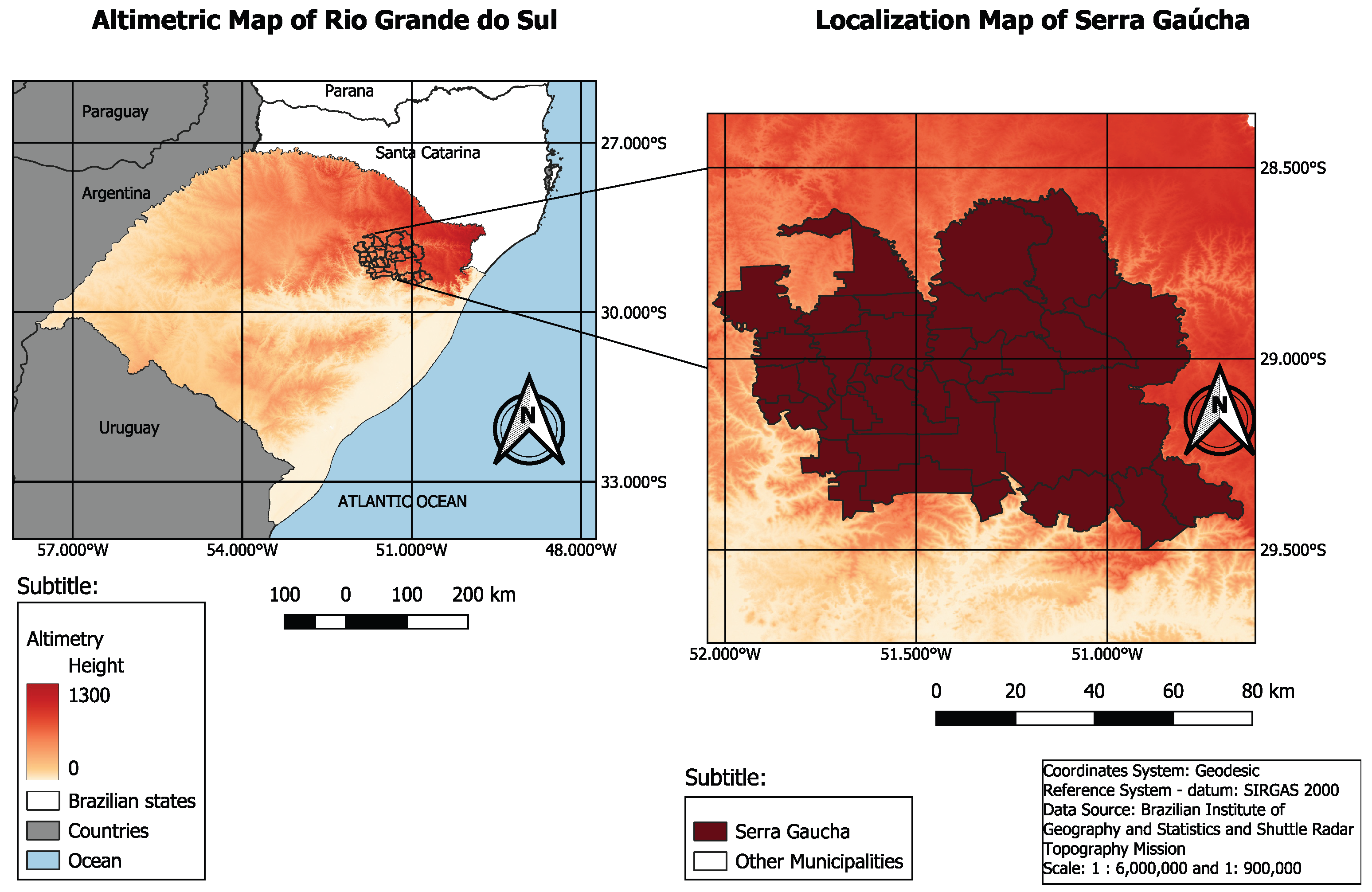
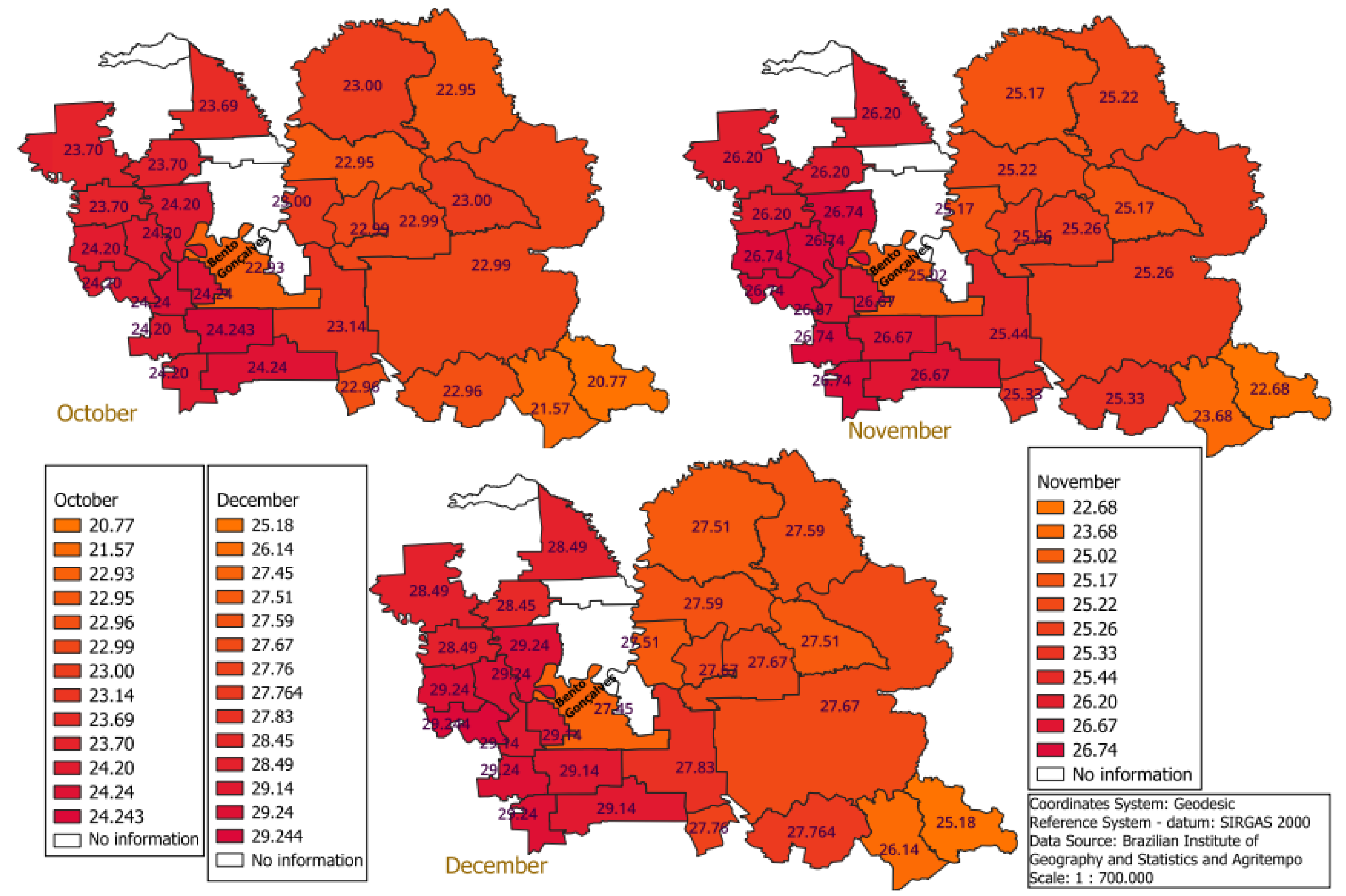

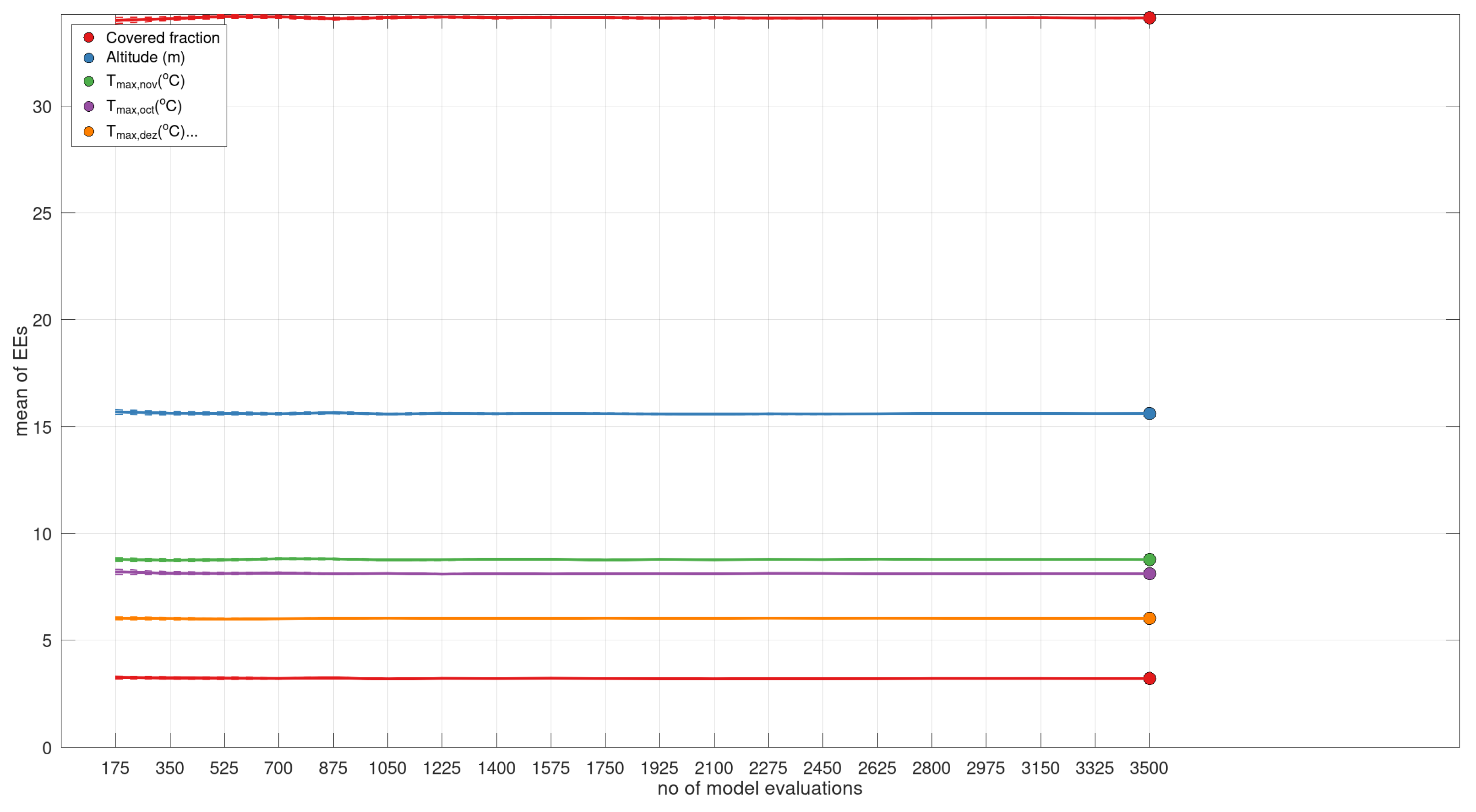
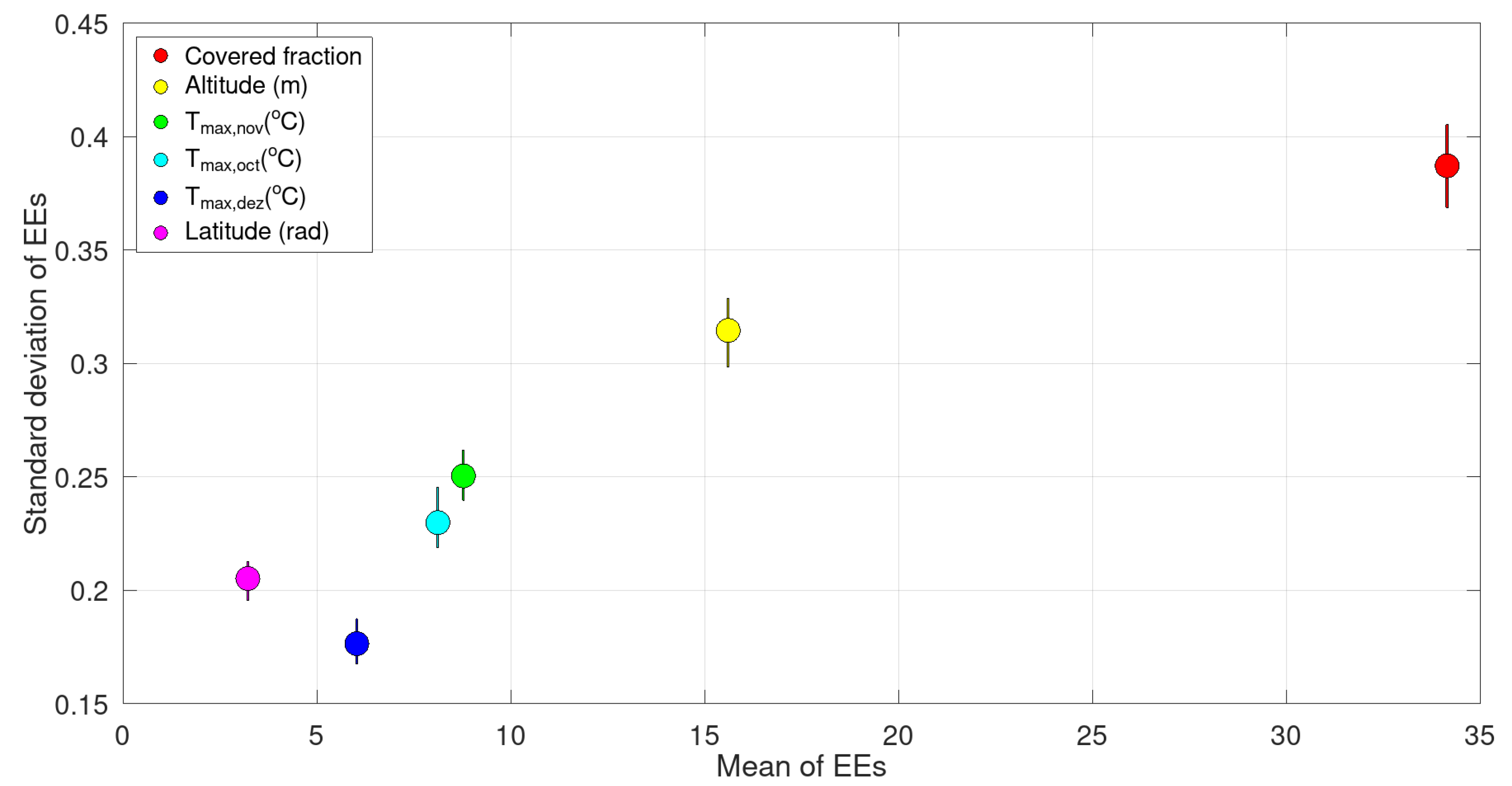
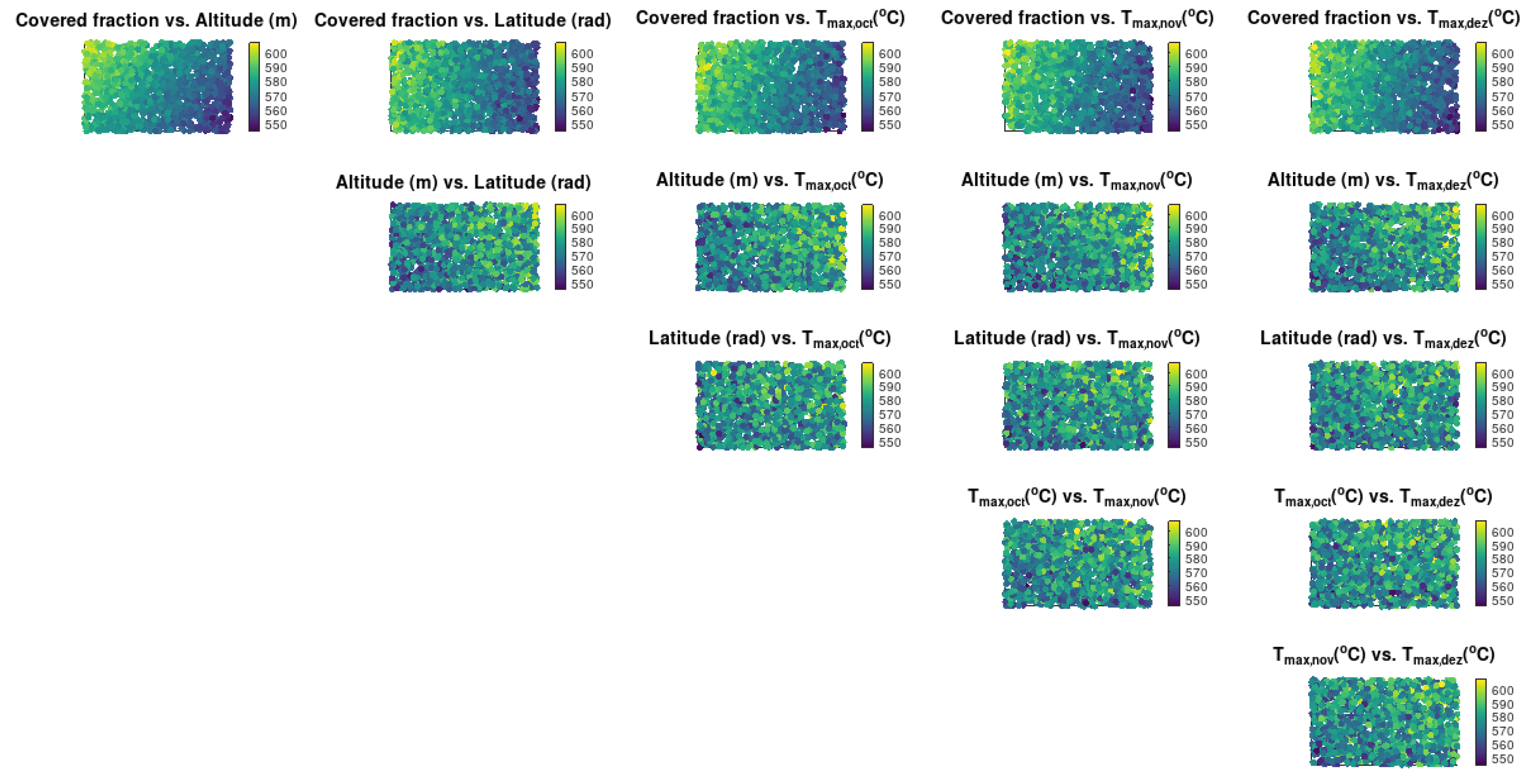
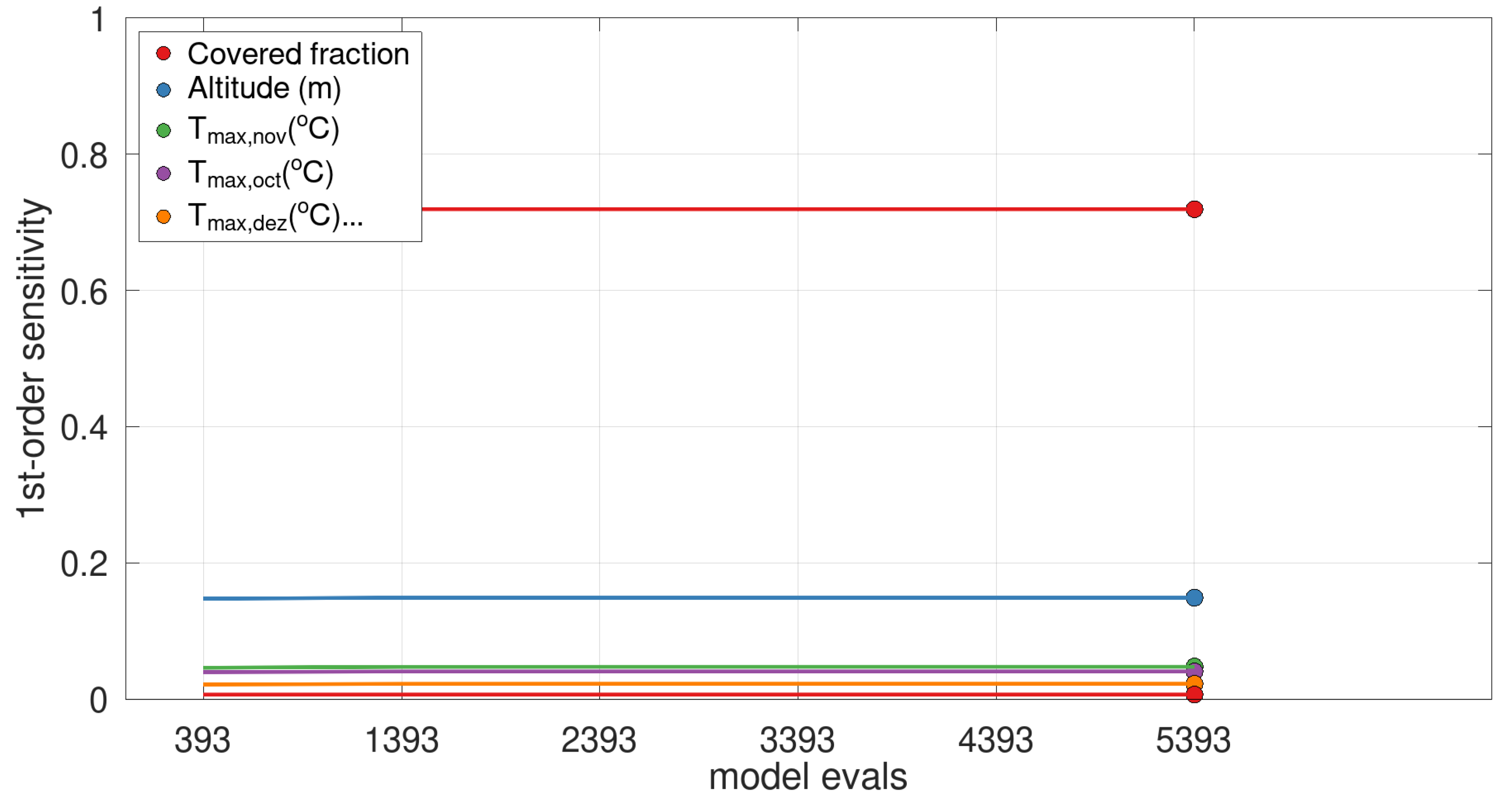
| Morris EE () | FAST Index | |
|---|---|---|
| Covered fraction | 34.2017 | 7.1938 |
| Altitude | 15.2832 | 1.4891 |
| Latitude | 2.9088 | 6.5333 |
| 7.6636 | 4.0507 | |
| 8.3152 | 4.7451 | |
| 5.9991 | 2.2368 |
Disclaimer/Publisher’s Note: The statements, opinions and data contained in all publications are solely those of the individual author(s) and contributor(s) and not of MDPI and/or the editor(s). MDPI and/or the editor(s) disclaim responsibility for any injury to people or property resulting from any ideas, methods, instructions or products referred to in the content. |
© 2024 by the authors. Licensee MDPI, Basel, Switzerland. This article is an open access article distributed under the terms and conditions of the Creative Commons Attribution (CC BY) license (https://creativecommons.org/licenses/by/4.0/).
Share and Cite
Platt, G.M.; Nunes, V.K.; Martins, P.R.; Corrêa, R.G.d.F.; Oliveira, F.B.S. The Modelling of the Evapotranspiration Portion of the Water Footprint: A Global Sensitivity Analysis in the Brazilian Serra Gaúcha. Earth 2024, 5, 133-148. https://doi.org/10.3390/earth5020007
Platt GM, Nunes VK, Martins PR, Corrêa RGdF, Oliveira FBS. The Modelling of the Evapotranspiration Portion of the Water Footprint: A Global Sensitivity Analysis in the Brazilian Serra Gaúcha. Earth. 2024; 5(2):133-148. https://doi.org/10.3390/earth5020007
Chicago/Turabian StylePlatt, Gustavo Mendes, Vinícius Kuczynski Nunes, Paulo Roberto Martins, Ricardo Gonçalves de Faria Corrêa, and Francisco Bruno Souza Oliveira. 2024. "The Modelling of the Evapotranspiration Portion of the Water Footprint: A Global Sensitivity Analysis in the Brazilian Serra Gaúcha" Earth 5, no. 2: 133-148. https://doi.org/10.3390/earth5020007
APA StylePlatt, G. M., Nunes, V. K., Martins, P. R., Corrêa, R. G. d. F., & Oliveira, F. B. S. (2024). The Modelling of the Evapotranspiration Portion of the Water Footprint: A Global Sensitivity Analysis in the Brazilian Serra Gaúcha. Earth, 5(2), 133-148. https://doi.org/10.3390/earth5020007








